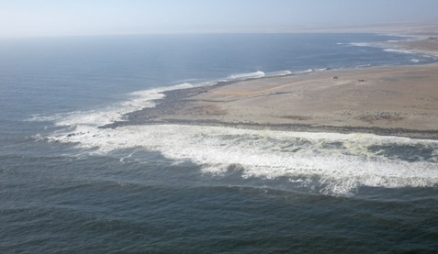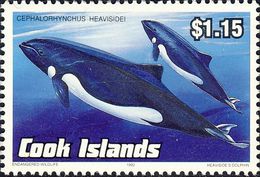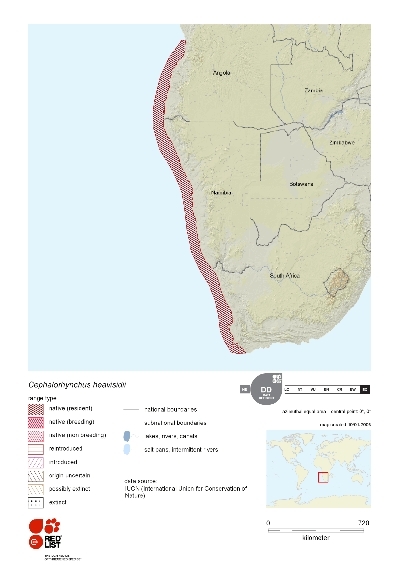Heaviside's dolphin (About the EoE)
Contents
Heaviside's dolphin
Heaviside's dolphin (scientific name: Cephalorhynchus heavisidii) is one of 36 species of Oceanic Dolphin in the family Delphinidae. Alternatively known as Haviside's dolphin, this species is one of 88 marine mammals in the order of cetaceans.
|
|
 Size comparison of an average human and a Heaviside's dolphin (Cephalorhynchus heavisidii). Source: Chris Huh Size comparison of an average human and a Heaviside's dolphin (Cephalorhynchus heavisidii). Source: Chris Huh
|
|
Conservation Status |
|
Scientific Classification Kingdom: Animalia |
|
Common Names: |
One of the most poorly known dolphins and also amongst the smallest, Heaviside's dolphin has a blunt head, rounded, paddle-like flippers, and bold markings. The front half of the stocky body is grey and the rear half is largely bluish-black. The flippers are dark and dark patches encircle the eyes and blowhole. The underside is white, as are the 'armpits' behind the flippers, and a distinct white finger-shaped marking extends from the belly along each flank.
Heaviside's dolphins, often seen in small groups of two to ten individuals, are not as lively or boisterous as some other dolphins, but nevertheless, have been occasionally seen riding the bow waves of boats. They feed on a wide variety of prey found in their coastal habitat, including small schooling fish, fish dwelling on the sea floor, and squid. While relatively little is known about the breeding biology of Heaviside's dolphin, characteristics are thought to be similar to that of closely related species. Males are thought to reach sexual maturity between the age of five and nine years, and females bear their first calf between six and nine years of age. Mating takes place in spring to late summer, and after a gestation period of 10 to 11 months, the calves are born. Mature females are believed to calve every two to four years.
Physical Description
Physical features include endothermic body temperature regulation and the morphology of complete bilateral symmetry. Heaviside's dolphin reaches physical maturity at about 1.68 to 1.70 metres in total length. It is a strongly built animal, its maximum girth averaging almost two-thirds of the body length. The head is cone shaped without a pronounced beak, and there are 24 to 35 teeth on each side of each jaw. The lower jaw invariably projects beyond the tip of the snout. The eyes are small and situated just above and behind the angle of the gape. The blowhole is on top of the head at about the same or slightly behind the level of the eyes (Reeves 1999, Nowak 1999).
Basically Cephalorhynchus heavisidii is a dark blue-black above with a grey "cape" over the head and thoracic region. A roughly diamond-shaped wedge of white runs across the chest with its lateral extremities curling around and terminating immediately in front of each flipper insertion. A trident-shaped white mark extends in the midline from about the level of the posterior insertion of the flippers to the anus, but with a lateral tongue-like extension up either side. This basic color pattern seems to be present at birth. Certain color variants in adults, notably partially albinistic individuals have been reported (Reeves 1999, Nowak 1999).
Behaviour
Key behaviours of the species are: natatorial; motile; and social. Heaviside's dolphins are usually found in small groups of from one to 10 animals, with two being the most common number. On some occasions, two groups can be found in close association, and it is possible that amalgamation into larger groups may occur. The overall proportion of calves in the groups is about 10%. Apart from the incidence of calves, nothing is known about the sex or age composition of these groups (Reeves 1999).
Certain groups of C. Heavisidii appear to be year round residents of particular areas. However, this remains an open question, as there is only limited evidence indicating this movement pattern (Reeves 1999).
Aerial displays by Heaviside's dolphins are comparatively rare. Individuals have been seen engaging in "tail-flips", where the animal leaps clear of the water but throws its tail high in the air, so that while its head re-enters the water with the body roughly vertical to the sea surface, the momentum of the jump carries the tail section past the vertical. The impression gained is of a rapid forward somersault (Reeves 1999). There is some evidence indicating that Heaviside's dolphins readily associate with sailing and/or motorized craft, sometimes "escorting" them for many hours (Reeves 1999).
Reproduction
Key reproductive features of this cetacean are: Gonochoric/gonochoristic/dioecious (sexes separate); and sexual (mating) reproduction. There is limited data on the reproduction of Cephalorhynchus heavisidii. There is evidence that young are born in the summer, although the length of gestation is unknown. The neonate is about 85 centimeters long, or half the length of a mature adult (Nowak 1999, Reeves 1999).
Distribution and Movements
This cetacean is typically found in coastal waters of southwestern Africa (Nowak 1999).
Habitat
Sightings of this dolphin have been made from the breaker zone to 45 nautical miles offshore, and in water depths up to 180 m, but the species is most abundant in the inshore region in depths of less than 100 m. Heaviside's dolphins have been found across a wide range of surface temperatures, but most sightings have been in water from nine to 15 degrees Celsius (Best and Abernethy 1999).
Food and Feeding Habits
Demersal fish such as hake (Merluccius capensis) and kingklip (Genypterus capensis) form about half of the diet of Heaviside's dolphin. Other prey include octopods, mollusks, gobies (Sufflogobius bibarbatus) and squid (Loligo reynaudi). This dolphin species appears to feed on bottom:dwelling organisms, demersal species that may migrate off the bottom (even to the surface) at night, and pelagic species that can be found from the surface to near the sea floor on the continental shelf (Reeves 1999).
Threats and Conservation Status
All species of Cephalorhynchus are subject to accidental killing by fisherman and crabbers; the genus is considered to be especially vulnerable to coastal purse seining. The extent to which Cephalorhynchus heavisidii is depleted by hunting is unknown, although it is reported that the species is sought after for its meat; there may be some hunting by harpoon (Nowak 1999, Reeves 1999, Fertl 1999).
The lack of information on Heaviside's dolphin makes it difficult to assess how threatened this species may be. Bycatch, whereby dolphins get entangled in fishing gear, represents one of the greatest threats this dolphin may face, but there is little information available on the numbers of individuals that may be killed in this manner. A number are also illegally hunted, apparently for their meat. The small distribution of Heaviside's dolphin makes it particularly vulnerable to any threats it may face.
Heaviside's dolphin is protected within 200 miles of the coast of South Africa, and 12 miles of Namibia, in Exclusive Fishery Zones in which all dolphins are protected. In addition, this species may benefit from its listing on Appendix II of the Convention on Migratory Species (CMS), which encourages range states (in this case Namibia and South Africa), to develop agreements for the conservation and management of the species. The IUCN Red List classifies this species as Data Deficient. This dolphin is listed by CITES in Appendix II.
Further Reading
- Encyclopedia of Life. Species curator: C.Michael Hogan. 2011. Cephalorhynchus heavisidii, Encyclopedia of Life (accessed Dec 21, 2011)
- IUCN Red List (April, 2007)
- S.M.Dawson. 2002. Cephalorhynchus dolphins. In: Perrin, W.F., Würsig, B. and Thewissen, J.G.M. Eds. Encyclopedia of Marine Mammals. Academic Press, London.
- CITES (April, 2007)
- CMS (April, 2007)
- Jefferson, T.A., Leatherwood, S. and Webber, M.A. (1993) FAO Species Identification Guide. Marine Mammals of the World. FAO, Rome.
- Carwardine, M., Hoyt, E., Fordyce, R.E. and Gill, P. (1998) Whales and Dolphins. HarperCollins Publishers, London.
- Reeves, R.R., Smith, B.D., Crespo, E.A. and di Sciara, G.N. (2003) Dolphins, Whales and Porpoises: 2002-2010 Conservation Action Plan for the World's Cetaceans. IUCN, Gland, Switzerland and Cambridge, UK.
- Culik, B.M., Würtz, M. and Gerkman, B. (2002) Review on Small Cetaceans: Distribution, Behaviour, Migration and Threats. Convention on Migratory Species, Bonn, Germany.
- Best, P., R. Abernethy. 1999. Heaviside's Dolphin. Pp. 289-310 in S. Ridgway, R. Harrison, eds. Handbook of Marine Mammals, Vol 5. London: Academic Press.
- Fertl, D. "African Marine Mammals" (On-line). Accessed December 10, 1999
- IUCN (2008) Cetacean update of the 2008 IUCN Red List of Threatened Species.
- Mead, James G., and Robert L. Brownell, Jr. / Wilson, Don E., and DeeAnn M. Reeder, eds. 2005. Order Cetacea. Mammal Species of the World: A Taxonomic and Geographic Reference, 3rd ed., vol. 1. 723-743
- Perrin, W. (2010). Cephalorhynchus heavisidii (Gray, 1828). In: Perrin, W.F. World Cetacea Database. Accessed through: Perrin, W.F. World Cetacea Database (accessed 2011-02-05).
- Rice, Dale W. 1998. Marine Mammals of the World: Systematics and Distribution. Special Publications of the Society for Marine Mammals, no. 4. ix + 231
- UNESCO-IOC Register of Marine Organisms
- Wilson, Don E., and DeeAnn M. Reeder, eds. 1993. Mammal Species of the World: A Taxonomic and Geographic Reference, 2nd ed., 3rd printing. xviii + 1207
- Wilson, Don E., and F. Russell Cole. 2000. Common Names of Mammals of the World. xiv + 204


